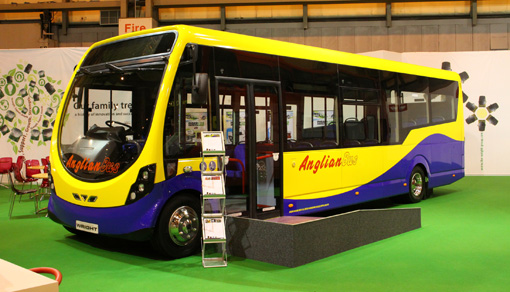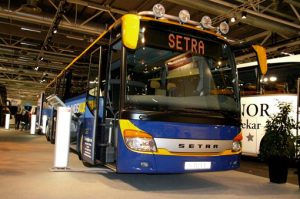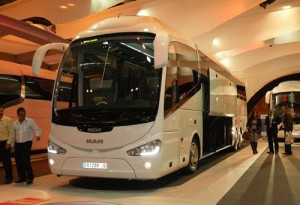
By Doug Jack

Following the massive exhibition in Hanover in September, a number of smaller regional exhibitions specifically for buses and coaches took place in Sweden, the United Kingdom and Spain. All three countries might be members of the European Union, but they exhibit fundamental differences in their manufacturing and bus operations.
Sweden
The first took place in Stockholm, the beautiful capital of Sweden, with the first cold winds of winter coming off the Baltic. Each of Sweden’s 28 counties controls its own bus services. Private sector companies, which include large international organizations, operate most of the operations on fixed term contracts.
Sweden has recently exerted strong political pressure for CNG or biogas fuelled buses. This is a win-win situation for local authorities because they can turn sewage and surplus food from hotels and restaurants into fuel for city buses and save substantially on disposal costs.
This strategy caught the two major domestic manufacturers, Scania and Volvo, rather flat-footed. MAN, and Solaris of Poland, captured some large orders, the latter using Cummins engines which can run on either gas or biogas. But at this exhibition, Scania and Volvo hit back, showing their latest CNG-powered city buses.
Another recent political initiative has seen the introduction of double deck coaches for commuter and shorter interurban journeys. One example was a Van Hool bodied Scania, one of 30 going into service.

United Kingdom
While there has been practically no interest in hybrid buses in Sweden, the United Kingdom now has more in use and on order than any other European market. Governments in London and Edinburgh have stimulated demand by awarding grants, which in some cases completely pay the additional price of a hybrid bus compared with a conventional diesel bus.
Alexander Dennis has taken the largest percentage of the business, using the BAE Systems hybrid drive well known in your country. With customers saying they are achieving around 30 percent in savings in fuel consumption, the two partners believe they can do better through further refinement of control systems and driver training.
Most of the Alexander Dennis hybrid vehicles are double deck. Stagecoach is running them in London, Oxford and Manchester with more on order for service in Sheffield and Newcastle.
Wrightbus, the first British manufacturer to start development of hybrid vehicles, has now standardized with the Siemens system using lithium-ion batteries. Until recently they relied on small Ford diesel units for thermal energy, but have now selected a larger and more durable Cummins engine.
Wrightbus also builds bodywork on diesel and hybrid Volvo chassis, including a fleet of 290 tri-axle double decks for Kowloon Motor Bus, Hong Kong. The two parties are also in the course of delivering 450 double decks to Singapore Bus Services, but these will have flat pack bodywork assembled locally.

The third British manufacturer is Optare, best known for its extensive range of midibuses. With the Indian giant, Ashok Leyland, recently acquiring a 26 percent shareholding, Optare has also developed hybrid buses under the government stimulus, and now offers an all-electric version of its popular Solo midibus.
The company also is a member in a consortium that is developing a hybrid vehicle that stores energy in a flywheel. The group will unveil its first model in early 2011.
MCV of Egypt established itself in the United Kingdom several years ago with its purchase of an old-established bodybuilder. MCV displayed its first-ever double deck city bus body with a customer’s name on it, which always lends credibility to a new project. A shorter version will meet the requirements of Transport for London. MCV also displayed one of 70 low entry single deck buses on Volvo chassis for KMB, Hong Kong, as well as a heavy-duty single deck on a Mercedes-Benz chassis for the British market.
Plaxton, a wholly owned subsidiary of Alexander Dennis, is our only remaining builder of luxury coachwork. It exhibited a 49-foot tri-axle coach for the Megabus.com in Great Britain. This model has a very clever arrangement for lifting a passenger in a wheelchair from the kerb to the main floor level of the vehicle.
The lift stored in the stairwell of the widened main entrance raises the passenger above the stairwell to a point level with the floor. A folding ramp folds forms a bridge to the floor, allowing the passenger to wheel into a modified seating position in the front of the coach. It is much more user-friendly than being hoisted up the outside of a coach, especially on a cold, dark, wet and windy night — and we have quite a lot of those.
Spain
Spain has traditionally relied mainly on imported chassis with locally built bodywork for its city buses and coaches. Daimler trades in Europe under the Mercedes-Benz and Setra brands. Already well established in Spain, Setra did not show one Spanish body on the Mercedes-Benz side of the stand.
Iveco Irisbus has a chassis manufacturing plant near Barcelona, but its exhibits included two city buses and a luxury coach built totally in France, plus two interurban vehicles built wholly in their factory in the Czech Republic.
Of the four vehicles on the MAN-Neoplan stand, only one had a Spanish body. Scania gave prominence to its new Touring coach, built jointly with Higer in China. Volvo’s display included a hybrid city bus and a luxury coach built in its factory in Poland. When times are hard, manufacturers have to give priority to filling their own factories first, but that is no comfort to some of the Spanish bodybuilders.

Irizar, the largest and only European bodybuilder with anything approaching a global presence, launched its new i6 integral coach with right hand drive in Birmingham, but in Madrid they showed six built on six different makes of chassis.
Irizar claims over 40 percent of the Spanish market for interurban and luxury coaches and obviously decided that the launch of a new integral product in its home market would have put the company in direct competition with all its chassis suppliers. Therefore, the plan is to offer the integral product in a number of export markets, starting with France and then probably Germany.
This shrewd decision gives Irizar the opportunity to gain experience of building and supporting its own integral products without antagonising its chassis partners. The critical question will be whether customers are more loyal to the chassis manufacturer or the bodybuilder.
With all products now branded Tata Hispano, Tata of India now owns 100 percent of Hispano, the second largest bodybuilder in Spain. The lines include two hybrid buses, one on an Alexander Dennis chassis and the other on Tata’s own build.
Until now, Spain has probably shown more interest in gas-fuelled buses than in hybrid vehicles. Castrosua, one of the main builders of city bus bodywork, combined the two technologies neatly with a CNG fuelled version of its Tempus hybrid bus. In spite of Spain’s problems, the general mood in FIAA was quite upbeat. However, the market looked a bit like musical chairs. Who will remain standing when the music stops?
Doug Jack is with Transport Resources in the United Kingdom.
